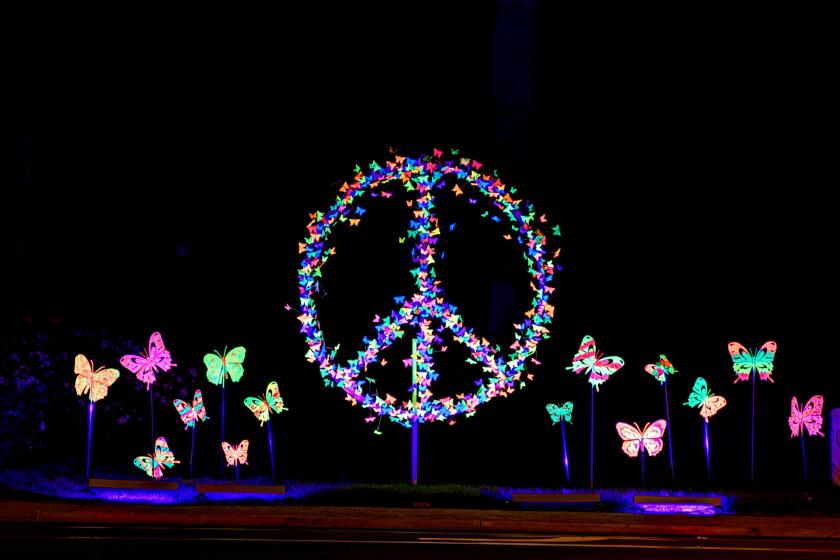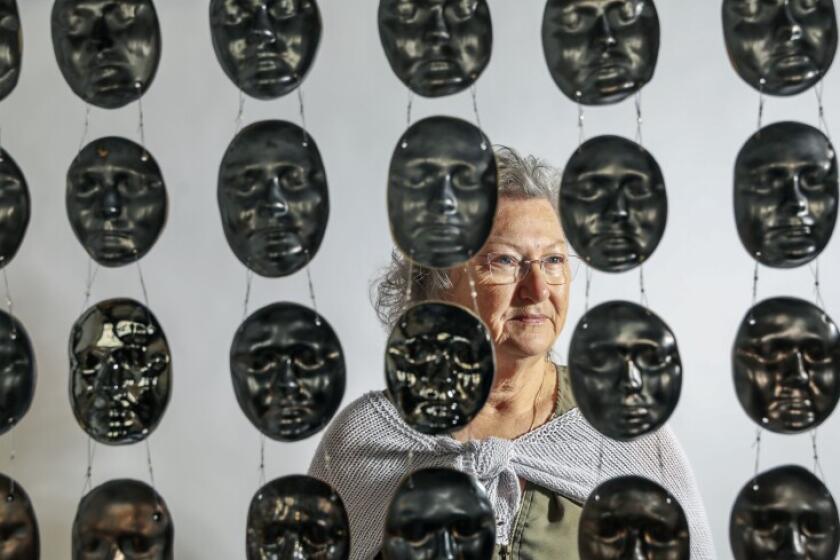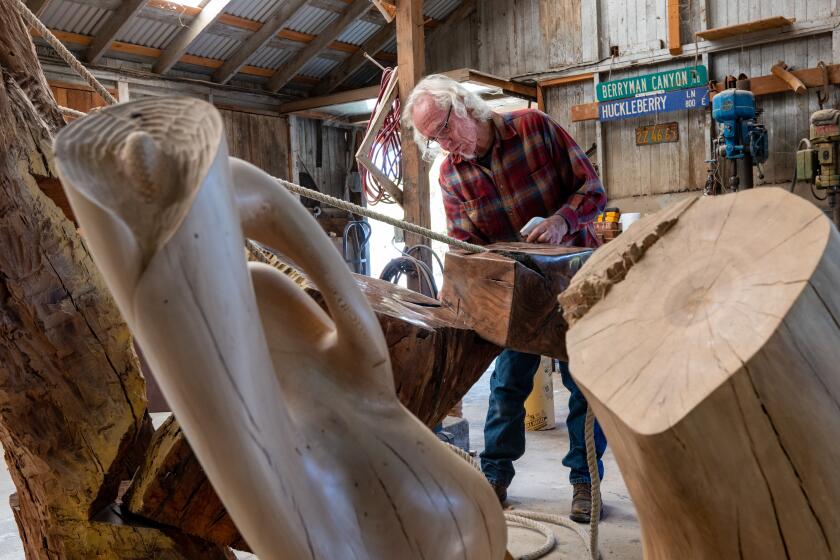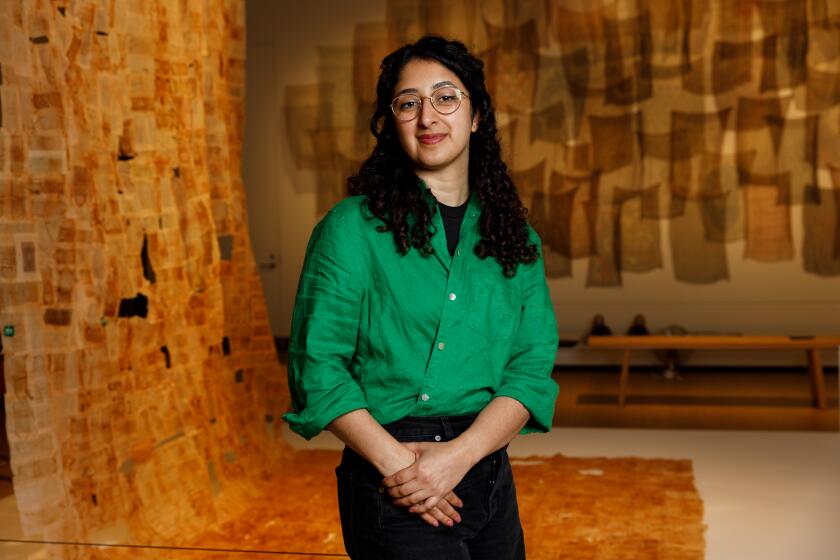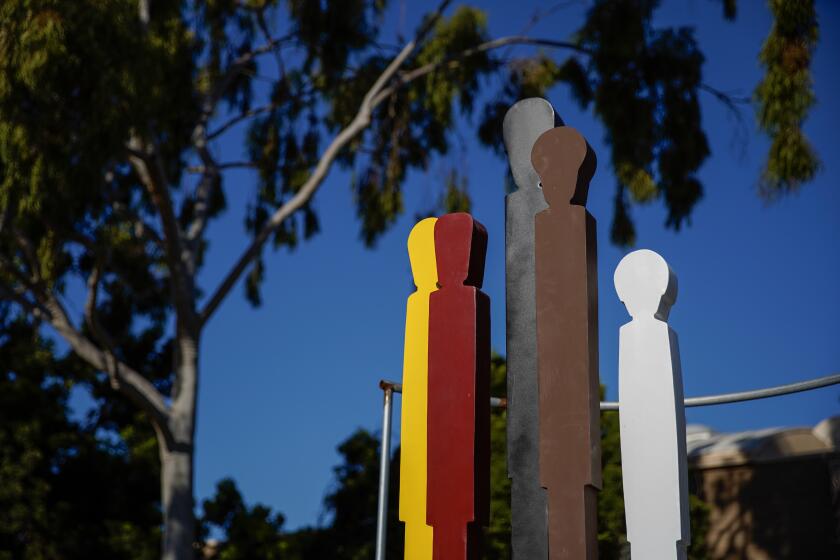Fred Tomaselli uses art to alter the mind at Oceanside Museum of Art
The art of Fred Tomaselli is like a modern-day cabinet of curiosity. The artist’s psychedelic paintings are crammed with an abundance of visual information — each one could be considered its own natural history museum.
An avid collector of natural media, the artist arranges these images and objects onto the surface of his work so that they appear to pulsate with an energy that moves beyond the edges of the canvas.
“Fred Tomaselli,” at the Oceanside Museum of Art through Dec. 2 and curated by Rhonda Gawthrop, features work from 1990 to the present and explores Tomaselli’s work thematically by organizing it into somewhat arbitrary categories to help view it through a few particular lenses.
Combining Western and Eastern symbols and traditions, the exhibit is a window into a surreal universe and is an exciting sampling of Tomaselli’s work over the years.
Tomaselli grew up in the shadow of Space Mountain in Anaheim and was highly influenced by the 1970s underground punk scene in Los Angeles. After moving to New York City in the 1980s, the heavy drug culture motivated him to start making images from pharmaceuticals and street drugs in highly organized and decorative patterns. These mesmerizing designs were encapsulated in resin and, instead of altering the mind through the bloodstream, these drugs were meant to alter the mind through the viewer’s eyes.
An aesthetic trip, the artist hoped that viewers would see and experience another reality through the process. This decision to embed pills, drugs, and marijuana leaves into his work continues to inform his desire to create transcendental encounters.
Although his artistic process and media has changed — Tomaselli stopped including pills in his work in 1994 — his imagery continued to develop.
While Tomaselli does not work with a particular direction in mind as he collects leaves, seeds and a host of images from magazines and catalogs (like birding guides), he does, however, carefully categorize and organize this visual information like an archivist.
Once he begins his studio process, images do materialize on his canvases, some more often than others. Two of these recurring themes are birds and the human figure. Tomaselli has a deep affinity for nature and is a devoted bird watcher. Spotting a bird from far away prompts an excited reaction, yet viewed up close through a pair of binoculars reveals an exquisite amount of details that would be impossible to see from a distance. Tomaselli’s images of birds function in the same way, as the large tails, feathers and beaks are quite apparent yet a closer look reveals a variety of tiny specimens.
The human form is another recurring structure that emerges from Tomaselli’s taxonomically oriented process. His compositions recall the unconventional 16th century Renaissance artist Giuseppe Arcimboldo. The Italian painter was known for his creative portraits made up of fruits and vegetables. These household items were overlapped and combined to wondrously construct identifiable figures that were both humorous and poignant.
Tomaselli’s figures, whether male or female, are constructed with their own unique, detectable series of shapes and symbols. The results resemble anatomical drawings one might find in a medical book yet appear to hold emotive qualities as well. These consistent transitions in perspective that we see in Tomaselli’s work points toward inner and an outer reality: things we see as opposed to things we feel.
The most exciting aspect of the survey exhibit is a selection of Tomaselli’s New York Times series. A body of work that started in 2005, the artist began to transform the front page of the Times into a collaborative space where he could address the current events of the day.
Rather than transporting the viewer, these images abruptly force the viewer to engage global and local issues of importance. These interventions can be both painful and humorous, depending upon the headlines that day. A never-ending cascade of information, they are a testament to determination, resilience and the notion that no matter what happens, you can continue to move on and try to make the world a better place.
While the images seem like a departure from Tomaselli’s collectively minded collages, the newspaper could be reframed in a similar perspective. The result of hundreds of people and experiences, the final product is an organized effort from a myriad of sources that the artist intervenes for his own purposes.
Tomaselli’s life and art are closely linked. From the hours he spends in his garden to his unusual upbringing in the artificial world of Orange County, these concepts consistently manifest in his work.
Fascinated with nature, Tomaselli’s cares for and facilitates the growth and health of his garden much like he nurtures his artistic process. These living works thrive and grow over time. Yet the faux landscape of Anaheim and the sensory drive it established in an impressionable and young Tomaselli never left him.
Questioning what is real and using an escapist aesthetic has been a historically important component to making work that is visually appealing. Idiosyncratic and enthralling, Tomaselli’s worlds of wonder are layered. The survey introduces and quickly transports viewers into a psychedelic Disneyland of color and form.
“Fred Tomaselli”
When: On exhibit through Dec. 2.
Where: Oceanside Museum of Art, 704 Pier Way, Oceanside
Tickets: $8 general admission, $5 seniors 65 and up.
Phone: (760) 435-3720
Online: oma-online.org
G. James Daichendt is dean of the colleges and professor of art history at Point Loma Nazarene University.
Get U-T Arts & Culture on Thursdays
A San Diego insider’s look at what talented artists are bringing to the stage, screen, galleries and more.
You may occasionally receive promotional content from the San Diego Union-Tribune.
